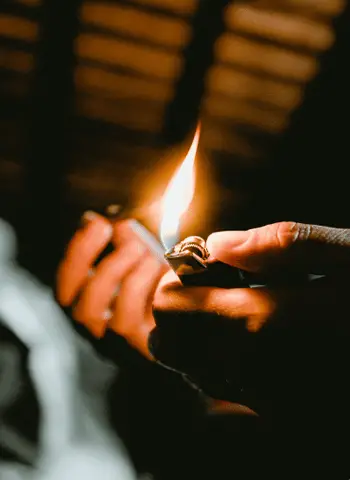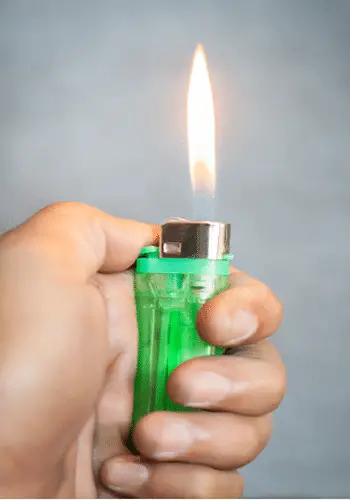Lighters have become an essential part of our daily lives. They are small, portable devices that use a flammable liquid or gas to produce a flame, making them convenient for use in a variety of settings. But have you ever stopped to wonder when were lighters invented?
The first lighter was invented in 1823 by Johann Wolfgang Dobereiner, and it was called the Dobereiner’s lamp. This lighter had a straightforward mechanism: When zinc metal reacts with sulfuric acid, flammable gas hydrogen is produced, which catches fire when it comes into contact with sparks at the container’s opening.
In this article, we’ll delve into the history of lighters and explore when they were first invented and how they have evolved over time. So if you’re interested in learning more about the history of lighters, keep reading!
When Were Lighters Invented and Why?

Lighters have been a staple in our everyday lives for many years, but do you know when was the first lighter invented?
The first lighter was invented in the early 19th century by a German chemist named Johann Wolfgang Döbereiner.
Döbereiner created the lighter as a more efficient and safer way to light his laboratory equipment, which at the time was typically lit using a flame from a candle or a match.
The lighter as we know it today, however, was not developed until the 20th century.
In 1932, a man named George G. Blaisdell founded Zippo Manufacturing Company and created the first Zippo lighter.
The Zippo lighter became popular due to its reliable and wind-resistant design, which made it the go-to lighter for soldiers during World War II.
Since then, lighters have become an integral part of everyday life for many people.
They are used to light cigarettes, candles, fireplaces, and even grill cooking.
There are many different types of lighters available today, including disposable lighters, refillable lighters, and even electric lighters.
Each type has its own unique features and benefits, but all serve the same purpose: to provide a reliable and convenient way to ignite a flame.
Zippo lighter
The Zippo lighter is a popular and well-known brand of lighter that was first developed by George G. Blaisdell in 1932.
Blaisdell founded Zippo Manufacturing Company in Bradford, Pennsylvania, and the company has been producing high-quality lighters ever since.
One of the reasons the Zippo lighter has become so popular is its reliability and durability.
The lighters are made with high-quality materials and are designed to last a long time, even with frequent use.
In fact, Zippo offers a lifetime warranty on all of its lighters, which is a testament to the company’s confidence in the quality of its products.
Butane lighters
Butane lighters are a type of lighter that uses butane gas as fuel to produce a flame.
They are commonly used to light cigarettes, candles, and outdoor grills, and are often preferred due to their convenience and ease of use.
Butane lighters are also refillable, which means that they can be used over and over again as long as they are refilled with butane gas.
Some butane lighters are even equipped with an adjustable flame, which allows the user to control the size and intensity of the flame depending on their needs.
BIC lighters
BIC lighters are a popular brand of disposable lighters that were first introduced in 1973.
They were developed by Marcel Bich, the founder of BIC Corporation, as a reliable and affordable alternative to traditional lighters.
One of the reasons Bic lighters have become so popular when was lighter invented is their convenience and ease of use.
They are small and lightweight, making them easy to carry around, and they do not require any special maintenance or refilling.
They are also relatively safe, as they are designed to extinguish the flame automatically when the lighter is closed.
Cigarette lighters
Cigarette lighters are a type of lighter specifically designed for lighting cigarettes. They are typically small and compact, making them easy to carry around and use on the go.
Cigarette lighters come in a variety of different styles and designs, including disposable lighters, refillable lighters, and even electric lighters.
Some cigarette lighters are designed to be especially wind-resistant, which makes them a reliable choice for lighting cigarettes outdoors.
In addition to being used to light cigarettes, cigarette lighters can also be used to light candles, fireplaces, and outdoor grills.
They are a convenient and essential tool for many smokers and are often carried in a pocket or purse for easy access.
Now that you know when were lighters invented, what about matches invention?
Disposable lighters
Cricket disposable lighters are a popular brand of disposable lighters that are known for their reliability and affordability.
These lighters are designed to be used once and then disposed of, making them convenient for those who do not want to deal with the hassle of refilling a lighter.
Cricket disposable lighters are also known for their safety features, including a child-resistant ignition system and an automatic extinguishing mechanism to prevent accidental fires.
In addition to being used to light cigarettes, Cricket disposable lighters can also be used to light candles, fireplaces, and outdoor grills.
Clipper lighters

Clipper lighters are a type of refillable lighter that is known for their unique design and durability.
These lighters are made with high-quality materials and are designed to last a long time, even with frequent use.
One of the standout features of Clipper lighters is their removable flint system, which allows the user to easily replace the flint as needed and extend the life of the lighter.
Since they may be used to light cigarettes, candles, fires, and outdoor grills, clipper lighters are also incredibly adaptable.
Due to the broad selection of forms and finishes offered, Clipper lighters are well-liked among collectors in addition to their useful applications.
Gas lighters
Gas lighters, also known as liquid fuel lighters, were first invented in the early 19th century. These lighters used a variety of different fuels, including naphtha and benzene, to produce a flame.
Since the early 19th century, when were gas lighter invented, gas lighters remained popular throughout the 19th and early 20th centuries.
However, they were eventually replaced by disposable and refillable lighters that used butane gas as fuel.
Who Invented Lighters?
So, who invented lighters? In the year 1823, Johann Wolfgang Döbereiner created the first lighter.
Chemist Döbereiner discovered that combining two distinct metals may result in an alloy that, when exposed to air, could ignite an electric spark.
This procedure, called electroplating, makes it possible to coat an object with a conductive metal oxide coating that can be utilized to spark when that object is touched or struck against another substance.
The “Döbereiner’s lamp,” as Döbereiner’s lighter was known, was made of two platinum wires that were spirally twisted together.
Each wire’s ends were covered with cotton that had been soaked in sulfuric acid.
One end of the spiral was dipped into the water while the other end was held above it to ignite the lamp.
When the cotton came into contact with both wires at once, the electrical current that was formed between them ignited the cotton.
Who Invented Flint Lighters?
Flint lighters are credited to an Austrian scientist by the name of Carl Auer von Welsbach.
In 1903, he obtained a patent for ferrocerium, which later became referred to as flint.
When he was just 19 years old in 1879, he started working on this project.
He was motivated by a friend who had been hurt while using a match to light his pipe.
Von Welsbach sought to eliminate the need to strike cigarettes and pipes against each other or with steel wool in order to make it simpler to light them.
Von Welsbach needed a material that could spark when it came into contact with something harsh, like steel wool or sandpaper, to do this.
While flint is a hard stone quartz that has historically been used to start fires, ferrocerium is a blend of metals manufactured by humans that generates a dazzling white spark.
Even though they are considerably different, between 1910 and 1930, ferrocerium lighters were still referred to as “flint lighters.”
Torch lighters invention
The Torch Lighter is a special kind of butane lighter that produces a very accurate, needle-like flame that is pushed by air.
It is identical to what you could find in a standard flick-style lighter. However, the delivery sets it apart.
Torch lighters produce a very precise, air-propelled needle-like flame that makes it simple and quick to light candles, pipes, or cigars without creating a mess or hassle.
Candles, incense, campfires, and barbecues can all be lit with the help of torch lighters.
If you want something a little fancier than your typical Bic lighter, you can even use them to light cigarettes.
Were Lighters Invented Before Matches?
Were lighters invented before matches?
I believe you now know when were lighters invented. The answer in no. lighters were invented in 1823, while matches existed in ancient China in the 5th century.
He used a fluid reservoir that held alcohol and a wick that was ignited by heat from an external flame, which would then ignite the fuel.
Matches have been around for centuries, first appearing in China around 5 BC.
The Chinese used firecrackers filled with sulfur as matches, which were lit by lighting them on fire with an open flame or ember from burning wood or charcoal.
The ancient Greeks also had their own version of matches called “sulfur-tipped” or “sulfur-head” matches made out of wood pulp dipped into sulfuric acid and dried over a lamp flame before being wrapped tightly around themselves so they would stay together when lit on fire.
Why Holding Lighters Up at Concerts?
Holding up lighters at concerts is a longstanding tradition, but many of us don’t know its history or purpose.
The tradition of putting your lighters up meaning at concerts started as an attempt to show appreciation for a performer and their work.
The use of light encourages participation, appreciation, and a demand for more from the audience by bringing them closer to the performer.
When you hold up a lighter during a performance, you’re saying that you appreciate what’s happening on stage—and that you want more!
It’s now common practice at concerts and festivals around the world, and it has become a way for audiences to participate in the show.
Cell phones have mostly taken the place of lighters at concerts today, but the phrase still has the same connotation as when it first appeared.
How Do Lighters Work?
As you know, lighters are an essential tool for lighting candles and campfires. But how do lighters work?
The lighter’s mechanism consists of two parts: one is called a “wheel” and another part is called an “igniter.”
Lighters are one of the most common ways to start a fire. They work by converting gas into a liquid, and then back into a gas again.
The lighter is filled with butane gas, which is kept under pressure.
When you press down on the button, it releases some of the butane into the air, where it becomes a gas and ignites when exposed to an open flame or spark.
Lighters are actually pretty simple in their design. A tiny stream of butane gas is released when you depressurize it by turning the thumb wheel.
The stream of gas then ignites when it comes into contact with a spark—like when you scrape flint against metal or strike a match.
Electric lighters
Electric lighters are a great alternative to the traditional butane lighter. They’re easy to use and make an excellent gift for anyone who likes to light up their smokes.
Electric lighters work by using a battery and an electrical circuit to create a spark that lights up.
The battery powers the circuit, which is made up of two metal contacts that are connected by a thin wire.
When you press the button on your lighter, you complete the circuit and create a spark that lights up your cigarette or cigar.
Plasma lighters
Many people are wondering how do plasma lighters work? Plasma lighters work by using a high-voltage arc to create heat instead of a flame.
The plasma lighter uses a small electric current that creates a ball of ionized gas.
This ball of ionized gas is called plasma and it is very hot. The plasma ball then heats up the fuel in the lighter and lights it on fire!
This process also produces a small amount of light as well as heat, but it’s not enough to ignite paper or other things that you might want to light on fire.
In order to get those things lit, you’ll need something else—like a spark from a flint wheel.
Car lighters
Years passed by from 1823 when were lighters invented until car lighters were invented. Car lighters are designed specifically for use in cars.
They’re usually made of metal or plastic and can be found in the glove compartment of most cars.
Car lighters are powered by electricity that comes from the battery in your car.
The electricity flows through a switch on one end of the lighter and into a coil inside the lighter where it is converted into heat energy by an electric current flowing through it from another source (usually from your car battery).
This heat energy causes a gas inside the lighter to expand rapidly which creates pressure within it and forces gas out of its nozzle tip.
There it mixes with oxygen in the air outside causing combustion which produces an open flame capable of igniting anything flammable nearby like paper, wood or even skin!
Arc lighters
Arc lighters work by igniting a small amount of fuel with a high-voltage electric arc.
The resulting flame is very hot, and it can reach temperatures above 2,000°C (3,632°F).
An arc lighter uses a small, concentrated area of high-voltage electrical current to produce heat instead of a flame.
This heat is hotter than a conventional lighter.
You simply set anything you want to light directly in the arc’s path after pressing a button to turn on the purple-hued arc.
History of Lighters
The history of lighters is quite interesting. The first lighter was made by Johann Wolfgang Dobereiner in 1823.
He created one of the first lighters in his home laboratory.
The lighter was made of two flint stones and a metal lighter fluid container. One of the flints would be struck with a metal object to create sparks when needed.
Dobereiner used this lighter to light his pipe, which he would then use to light a candle or other things that needed to be lit on fire.
He never patented his invention and it did not catch on until later when others started using it as well.
There were several improvements made to his original design over the years, including ones that used flint and steel instead of flint stones.
There were also improvements made to the metal container so that it could hold more fluid without leaking out onto clothing or hands during use (this was before people had any idea about safety regulations).
Conclusion
In conclusion, from the 19th century, when were lighters invented as a safer way to light laboratory equipment, the modern lighter as we know it today was developed in the 20th century.
Do you have a go-to brand or type of lighter that you prefer, or do you switch it up depending on your needs?
Share your thoughts and experiences with lighters in the comments below.


